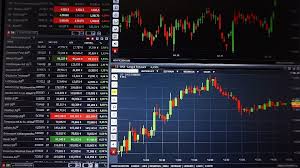Best Indicators for Forex Trading 1901231797

Best Indicators for Forex Trading
In the world of Forex trading, having the right tools at your disposal can make a significant difference in your trading performance. Among those tools, indicators play a crucial role in helping traders analyze the market, predict price movements, and make informed decisions. In this article, we will delve into some of the best indicators for Forex trading, explore how they work, and provide tips on using them effectively. For a comprehensive trading experience, consider using a reliable platform such as best indicators for forex trading Trading Platform VN.
What Are Forex Indicators?
Forex indicators are quantitative tools used by traders to analyze currency pairs and forecast future price movements. They are derived from various mathematical calculations based on historical price data. Indicators can be broadly categorized into two types: leading and lagging indicators. Leading indicators attempt to predict future price movements, while lagging indicators analyze past price data to confirm trends.
1. Moving Averages
One of the most widely used indicators in Forex trading is the moving average (MA). There are several types of moving averages, including Simple Moving Average (SMA) and Exponential Moving Average (EMA). MAs help smooth out price data to create a trend-following indicator.
Traders often use MAs to determine entry and exit points. For instance, when the short-term MA crosses above the long-term MA, it generates a buy signal. Conversely, when the short-term MA crosses below the long-term MA, it indicates a sell signal. MAs are essential for identifying the overall trend of a currency pair.
2. Relative Strength Index (RSI)
The Relative Strength Index (RSI) is a momentum oscillator that measures the speed and change of price movements. The RSI moves between 0 and 100 and is typically used to identify overbought or oversold conditions in a market.
A reading above 70 indicates that a currency pair may be overbought, while a reading below 30 suggests it may be oversold. Traders often use these levels to make decisions about entering or exiting trades, as extreme readings can precede price reversals.

3. Moving Average Convergence Divergence (MACD)
The MACD is a popular trend-following momentum indicator that shows the relationship between two moving averages of a security’s price. The MACD is calculated by subtracting the 26-period EMA from the 12-period EMA. The result of this calculation is the MACD line.
The MACD can generate buy and sell signals in two primary ways: through crossovers and divergences. A bullish crossover occurs when the MACD line crosses above the signal line, indicating potential upward momentum. Conversely, a bearish crossover happens when the MACD line crosses below the signal line.
4. Bollinger Bands
Bollinger Bands consist of a middle band (SMA) and two outer bands that are typically set two standard deviations away from the SMA. This results in a channel that expands and contracts based on market volatility.
Traders use Bollinger Bands to identify potential reversal points and volatility. When the price touches the upper band, it may signal that the currency pair is overbought, and when it touches the lower band, it may be oversold. Traders can also look for price breakouts when the bands contract.
5. Stochastic Oscillator
The Stochastic Oscillator is another popular momentum indicator that compares a security’s closing price to its price range over a specific period. It consists of two lines, %K and %D. The %K line is the primary line, while the %D line is a moving average of the %K line.
The Stochastic Oscillator ranges from 0 to 100. Readings above 80 indicate overbought conditions, and readings below 20 suggest oversold conditions. Traders can use these levels to make decisions regarding potential entry and exit points.
6. Average True Range (ATR)

The Average True Range (ATR) is a volatility indicator that measures the range of price movements over a specific period. It does not indicate the direction of price movement but provides valuable information about market volatility.
Traders often use the ATR to set stop-loss levels and determine position sizes. A higher ATR value indicates higher volatility, and traders may choose to adjust their risk management strategies accordingly.
7. Fibonacci Retracement
Fibonacci retracement levels are horizontal lines that indicate potential support and resistance levels based on the Fibonacci sequence. Traders draw these levels by identifying the high and low points of a price movement.
Commonly used Fibonacci levels are 23.6%, 38.2%, 50%, 61.8%, and 100%. Traders use these levels as potential reversal zones, looking for price action around these levels to make decisions about entering or exiting trades.
Using Indicators Effectively
While indicators can provide valuable insights, it is essential to use them in conjunction with other forms of analysis. Here are some tips for using indicators effectively:
- Do Not Rely on One Indicator: Avoid relying solely on one indicator for decision-making. Use a combination of indicators to confirm signals and reduce the risk of false positives.
- Understand Market Conditions: Different indicators perform better in trending markets versus ranging markets. Adapt your indicator usage based on the prevailing market conditions.
- Combine with Price Action: Incorporate price action analysis together with technical indicators to enhance your trading strategy. Price action can provide context to indicator signals.
- Backtest Your Strategy: Before trading with real money, backtest your strategy using historical data to gauge its effectiveness. This will help you refine your approach and improve your overall results.
Conclusion
Indicators are invaluable tools for Forex traders, helping to analyze market conditions and make informed trading decisions. Understanding the various indicators and how to use them effectively can greatly enhance your trading strategy. Remember, no indicator is foolproof, so always practice proper risk management and continuously improve your trading skills. Whether you are a beginner or an experienced trader, incorporating these indicators into your trading toolkit can pave the way for more successful trades.

